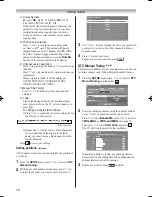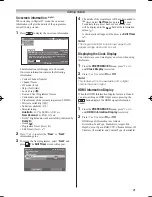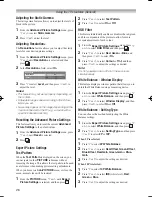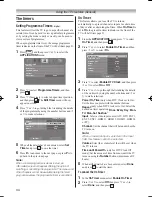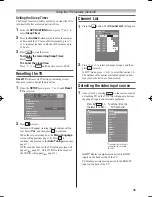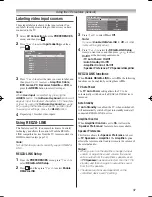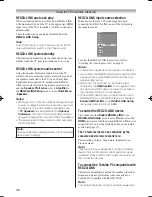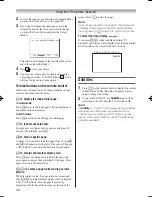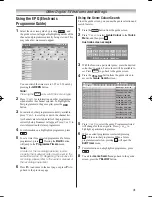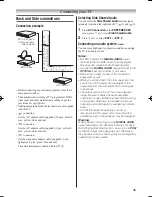
30
Using the TV’s features (General)
Setting Automatic Power Down
The TV will automatically turn itself off (standby) after
approximately 4 hours, if you do not operate the control
buttons on the remote control or on the TV control panel�
1
From the
PREFERENCES
menu, press
s
or
r
until
Energy Saving Settings
is selected, and then
press �
2
Press
s
or
r
to select
Automatic Power Down
,
press
v
or
w
to select
On
or
Off
, and then press
EXIT
�
Notes:
•
This feature is set to
On
when
Location
is set to
Home
.
•
1 minute before switching to standby, a warning
message will appear.
•
The TV will automatically turn itself off after
approximately 1 hour if you do not operate the TV
(after it is turned on by the
On Timer
).
Setting No Signal Power Down
The TV will automatically turn itself off after 15 minutes
when no signal is detected� You can change the setting to
Off
for the following purposes:
• Low signal strength of analog channel (no signal
detection)
• Only Audio L/R is connected to an external input in
order to listen to music through the TV speakers�
1
From the
Energy Saving Settings
menu, press
�
2
Press
s
or
r
to select
No Signal Power Down
,
and then press �
3
Press
s
or
r
to select the item you want to change,
and press
v
or
w
to select
On
or
Off
�
Notes:
•
Default setting is all
On
.
•
A warning message will appear 1 minute before
turning off.
Viewing 3D images
Before using the 3D feature, please read the
following�
Viewing 3D programming requires the following (which
are not included):
• Compatible Toshiba 3D glasses (only one supplied).
• Compatible 3D playback device or 3D source.
• 3D capable HDMI cable.
Health precautions:
• Due to the possible impact on vision development,
viewers of 3D programming should be age 6 or above�
Children may be more susceptible to health effects from
viewing 3D images and should be closely supervised�
• Some viewers may experience a seizure or blackout
when exposed to certain flashing images or lights
contained in certain 3D TV pictures or video games�
Anyone who has had a seizure, loss of awareness, or
other symptoms linked to an epileptic condition, or has
a family history of epilepsy, should consult a health care
provider before using the 3D feature of this product�
How to use the 3D glasses:
Please refer to the 3D Glasses' Owner's Manual�
Precautions for daily use of 3D glasses:
Notes on handling the 3D glasses' liquid
crystal shutter lenses:
•
Do not put excessive force on the lenses.
•
Do not scratch the surface of the lenses with sharp
objects.
•
Do not drop or bend the 3D glasses.
Notes on IR communication:
•
Do not block the IR sensor for 3D glasses on the
TV by placing objects in front of it.
•
Do not cover the IR sensor on the 3D glasses with
stickers or labels.
•
Keep the IR sensor on the 3D glasses clean.
•
If the 3D glasses interfere with any other IR
communication device or 3D TV, the 3D glasses
may not work correctly. Also, the TV may interfere
with the operation of other IR communication
devices. Use the TV and 3D glasses in a place
where they will not interfere with other devices or
products.
Notes on watching the TV:
•
If you use any device, such as a mobile phone or
mobile wireless device, near the 3D glasses, the
3D glasses may not work correctly.
•
Use the product in the following temperature
range; otherwise, the quality of the 3D image or the
reliability of the product cannot be guaranteed.
- 3D glasses: 0°C - 40°C
- TV: 0°C - 35°C
•
If you use a fluorescent light, it may flicker
depending on the frequency of the light. In this case,
reduce the brightness of the fluorescent light, or use
another light. (It is not recommended to watch the
TV in a dark room, especially for children.)
•
Wear the 3D glasses properly, otherwise you may
not see the correct 3D image.
•
When not viewing 3D images, take off the 3D
glasses; otherwise, it may be difficult to see the
display on other products such as PC, digital clock
or calculator, etc.
Summary of Contents for 46WL700A
Page 80: ......



